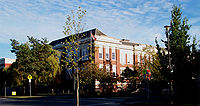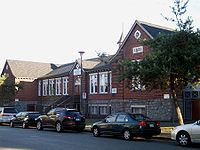
Lord Strathcona Elementary School
Encyclopedia

Vancouver
Vancouver is a coastal seaport city on the mainland of British Columbia, Canada. It is the hub of Greater Vancouver, which, with over 2.3 million residents, is the third most populous metropolitan area in the country,...
, British Columbia
British Columbia
British Columbia is the westernmost of Canada's provinces and is known for its natural beauty, as reflected in its Latin motto, Splendor sine occasu . Its name was chosen by Queen Victoria in 1858...
. It was founded in 1891 and is in the secondary school catchment area for Britannia Secondary School
Britannia Secondary School
Britannia Community Secondary School is a public community secondary school located in the Grandview–Woodland neighbourhood on the east-side of Vancouver, British Columbia. The school educates its students using a district-wide block schedule program that alternates four blocks every two days....
. It is located in the Strathcona
Strathcona (Vancouver)
Strathcona is Vancouver, British Columbia's oldest residential neighbourhood. It is bordered by Chinatown to the west, Clark Drive to the east, Burrard Inlet on the north, and Canadian National Railway and Great Northern Railway classification yards to the south.-History:Over 8,000 people now live...
neighbourhood and has a culturally diverse student body. There is also a "Gifted Education Challenge Centre" on-site. The school is attached to a community centre and the school library doubles as a branch of the Vancouver Public Library
Vancouver Public Library
The Vancouver Public Library is the third largest public library system in Canada, with more than 2.5 million items in its collections, 22 branches, approximately 375,000 cardholders, and nearly nine million item borrowings annually...
.
History
Prior to the 1950s, the neighbourhood served by Lord Strathcona was called the East End. The new name was probably chosen because of the school. It is the oldest residential neighbourhood in Vancouver, and since its inception has been predominantly working classWorking class
Working class is a term used in the social sciences and in ordinary conversation to describe those employed in lower tier jobs , often extending to those in unemployment or otherwise possessing below-average incomes...
in its composition, although the earliest business elite also lived there. Lord Strathcona Elementary School is descended from the first two schools in Vancouver: the Hastings Mill School and the Oppenheimer Street School. The Hastings Mill School opened in 1873 but was demolished in 1886 because it was located on the CPR
Canadian Pacific Railway
The Canadian Pacific Railway , formerly also known as CP Rail between 1968 and 1996, is a historic Canadian Class I railway founded in 1881 and now operated by Canadian Pacific Railway Limited, which began operations as legal owner in a corporate restructuring in 2001...
right-of-way. It was replaced by the Oppenheimer School at 522 Oppenheimer Street (now East Cordova) in 1887, but that building was soon too small for the ballooning population. The new school, known as the East End School before 1900, was situated at the highest elevation point in the neighbourhood.
The East End School was housed in the first building on the Strathcona site, which was completed in 1891. Another building was added in 1897, the Junior Building, and is still used today. A north wing was added in 1915, and in 1921, the bricks from the original (now demolished) 1891 structure were used to build the current Primary Building. The Senior Building on Jackson Street was erected in 1913 and the gymnasium in 1930. The adjacent Strathcona Community Centre opened in 1972 and contains a branch of the Vancouver Public Library
Vancouver Public Library
The Vancouver Public Library is the third largest public library system in Canada, with more than 2.5 million items in its collections, 22 branches, approximately 375,000 cardholders, and nearly nine million item borrowings annually...
that doubles as the school library. The Community Centre also provides several services for Strathcona children, such as after school care and other programs.
Following the arrival of the CPR in Vancouver, the wealthy elite (mostly English, Scottish, and Irish) gravitated west to the new upscale developments of the West End
West End, Vancouver
The West End of Vancouver, British Columbia, Canada is on the downtown peninsula neighbouring Stanley Park and the areas of Yaletown, Coal Harbour and the downtown financial and central business districts....
, and later, Shaughnessy. This process was complete by the Great War, after which the East End was inhabited mostly by successive waves of immigrants, including: Japanese, Chinese, Norwegians, Swedish, Finnish, Jewish, African-Americans, Central Americans, Italians, French, Germans, Spanish, Portuguese, Belgians, Russians, Polish, Ukrainians, Hungarians, Croatians, Romanians, Czech, Slovak, Turkish, Albanians, and Serbians. The major cultural groups at Strathcona were the Chinese, Japanese, Italian, and Jewish. The latest wave of immigrants was the Vietnamese in the 1970s.
During the interwar period, the school gained the nickname "The League of Nations" because of the diversity of ethnic groups represented in the student population. Teachers were faced with the exceptional challenge of teaching the non-English speaking children and youth. The immigrant experience was the unifying factor for these students, but even then, racial and ethnic tensions played out at Strathcona that mirrored divisions in Vancouver's adult population. The city had become much more racially and ethnically segregated over time, and after the wealthier Anglo-Celtic population left the East End, the pattern of economic marginalization that still persists today set in. In the Great Depression
Great Depression
The Great Depression was a severe worldwide economic depression in the decade preceding World War II. The timing of the Great Depression varied across nations, but in most countries it started in about 1929 and lasted until the late 1930s or early 1940s...
, economic disparities were even more pronounced. During that decade, Strathcona had a bathtub in the basement of the Senior Building so that teachers could bathe children coming from homes with no hot water.
Distinctive characteristics of the school are its relationship with the adjoining Strathcona Community Centre and the ethnic diversity of the student body. The segregated organization of Vancouver however did not mean that these primarily working class children were entirely separated from the middle class and Anglo-Celts who now lived in other areas. The teachers at Strathcona generally did not come from same socio-economic background as the students, for example, and the men who policed the youth in the area were primarily Scottish, and later, English and Irish as well. On one occasion in 1935, striking longshoremen chased a group of strikebreakers through the halls of Strathcona, showing again how developments and conflicts unfolding in Vancouver often found an expression in the school.

Gastown
Gastown is a national historic site in Vancouver, British Columbia, at the northeast end of Downtown adjacent to the Downtown Eastside. Its historical boundaries were the waterfront , Columbia Street, Hastings Street, and Cambie Street, which were the borders of the 1870 townsite survey, the proper...
and in pockets within the Downtown Eastside such as the area around the intersection of Keefer and Abbott Streets, have brought more middle class immigrants and non-immigrants to the area. Other ethnic groups are no longer concentrated in the area, such as the Italian and Jewish communities that have dispersed throughout the city or concentrated in other areas such as Little Italy. Two groups were involuntarily displaced from the Strathcona area, and are therefore no longer represented in the same proportion as before: the Black community after the destruction of Hogan's Alley, and the Japanese after their internment
Japanese Canadian internment
Japanese Canadian internment refers to confinement of Japanese Canadians in British Columbia during World War II. The internment began in December 1941, following the attack by carrier-borne forces of Imperial Japan on American naval and army facilities at Pearl Harbor...
during World War II
World War II
World War II, or the Second World War , was a global conflict lasting from 1939 to 1945, involving most of the world's nations—including all of the great powers—eventually forming two opposing military alliances: the Allies and the Axis...
.
A "Charter of Respect" was adopted as part of a campaign to discourage bullying and foster a safe learning environment.
Facilities
Lord Strathcona is unique in having community centre facilities within the complex.The Strathcona Community center has multicultural diversities.Sports
Lord Strathcona has teams for the following sports:- BasketballBasketballBasketball is a team sport in which two teams of five players try to score points by throwing or "shooting" a ball through the top of a basketball hoop while following a set of rules...
- Cross CountryCross country runningCross country running is a sport in which people run a race on open-air courses over natural terrain. The course, typically long, may include surfaces of grass and earth, pass through woodlands and open country, and include hills, flat ground and sometimes gravel road...
- Flag FootballFlag footballFlag football is a version of Canadian football or American football that is popular worldwide. The basic rules of the game are similar to those of the mainstream game , but instead of tackling players to the ground, the defensive team must remove a flag or flag belt from the ball carrier to end...
- Soccer
- SoftballSoftballSoftball is a bat-and-ball sport played between two teams of 10 to 14 players. It is a direct descendant of baseball although there are some key differences: softballs are larger than baseballs, and the pitches are thrown underhand rather than overhand...
- Track and FieldTrack and fieldTrack and field is a sport comprising various competitive athletic contests based around the activities of running, jumping and throwing. The name of the sport derives from the venue for the competitions: a stadium which features an oval running track surrounding a grassy area...
- VolleyballVolleyballVolleyball is a team sport in which two teams of six players are separated by a net. Each team tries to score points by grounding a ball on the other team's court under organized rules.The complete rules are extensive...
Lord Strathcona also has an intramural school hockey league which is played in the gym called the Strathcona Hockey League (SHL). The SHL has been in Lord Strathcona for more than 10 years now and has been a great success for being a good athletic activity for young students,from grades 4-7.
Over the last three years the program has been expanded to include all grades including the primary grades and Kindergarten.
Sources
- Daphne Marlatt and Carole Itter, eds., Opening Doors: Vancouver's East End, Sound Heritage series, Vol. VIII, nos. 1-2. Victoria, BC: Aural History Program, 1979.
- Harold Kalman, Exploring Vancouver: Ten Tours of the City and its Buildings, Vancouver: University of British Columbia Press, 1974.
- Stanley D. McLarty, The Story of Strathcona School. Vancouver: Vancouver School Board, 1961.
- Lord Strathcona Elementary School websitehttp://strathcona.vsb.bc.ca/

